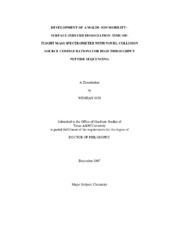| dc.contributor.advisor | Russell, David H. | |
| dc.creator | Sun, Wenjian | |
| dc.date.accessioned | 2010-01-15T00:07:01Z | |
| dc.date.accessioned | 2010-01-16T00:34:10Z | |
| dc.date.available | 2010-01-15T00:07:01Z | |
| dc.date.available | 2010-01-16T00:34:10Z | |
| dc.date.created | 2007-12 | |
| dc.date.issued | 2009-05-15 | |
| dc.identifier.uri | https://hdl.handle.net/1969.1/ETD-TAMU-2454 | |
| dc.description.abstract | A Matrix-assisted Laser Desorption/Ionization (MALDI) – Ion Mobility (IM) – Surface-induced Dissociation (SID) – Time-of-Flight (TOF) instrument with three different collision source configurations was developed in order to improve the SID performance in high throughput peptide sequencing. The first version of the instrument was equipped with an angle resolved SID source in order to maximize the collection efficiency of the SID scattering ions. An orthogonal TOF was also implemented as the second MS stage in this instrument to increase mass resolution. The second version of the instrument was developed towards simplifying the coupled configuration of the IM, SID and TOF components by using a combined SID/TOF source with a confinement ring electrode as the collision target. The fragmentation efficiency of SID in this configuration was increased up to 50% due to the surface normal impact angle used as compared with the results from a previous experiment using 45 degree impact angle. The third version of the instrument was equipped with a dual-source/dual-detector TOF to facilitate high throughput tandem analysis of peptides through simultaneous separation, fragmentation and mass analysis, while retaining precursor ion identity in the same experimental sequence. A series of small organic molecules, model peptides and tryptic peptides from a protein digest were analyzed to demonstrate the utility of these new designs for enhanced SID performance and peptide sequencing capability. Finally, a new mobility drift cell using a periodic focusing mechanism has been designed and fabricated to replace the previous uniform field drift cell. Improvement in ion transmission has been observed in the periodic focusing drift cell instrument without sacrificing the mobility resolution. | en |
| dc.format.medium | electronic | en |
| dc.format.mimetype | application/pdf | |
| dc.language.iso | en_US | |
| dc.subject | Ion Mobility | en |
| dc.subject | Surface-induecd Dissociation | en |
| dc.subject | Peptide Sequencing | en |
| dc.title | Development of a maldi − ion mobility− surface-induced dissociation − time-of-flight mass spectrometer with novel collision source configurations for high throughput peptide sequencing | en |
| dc.type | Book | en |
| dc.type | Thesis | en |
| thesis.degree.department | Chemistry | en |
| thesis.degree.discipline | Chemistry | en |
| thesis.degree.grantor | Texas A&M University | en |
| thesis.degree.name | Doctor of Philosophy | en |
| thesis.degree.level | Doctoral | en |
| dc.contributor.committeeMember | Cote, Gerard L. | |
| dc.contributor.committeeMember | Goodman, D. Wayne | |
| dc.contributor.committeeMember | North, Simon W. | |
| dc.type.genre | Electronic Dissertation | en |
| dc.type.material | text | en |
| dc.format.digitalOrigin | born digital | en |


